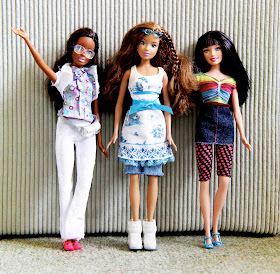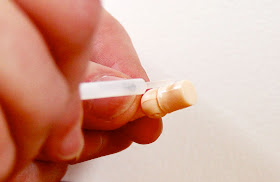I don't know if any of you guys have ever bought a second-hand figure, but, is it just me, or was the previous owner always an idiot? ... more on that in a minute...
Today I will be discussing how to cover up blemishes on doll clothes using acrylic paint.
It may sound weird that I am suggesting that you paint your dolls' real fabric clothing, but, with a little tact, it works amazingly well.
Back to my beef from earlier... Pretty much all of my "used" figures had some kind of stupid problem when they arrived. The stupidest was RAH Edward Elric, whose previous owner had thought it was a good idea to wash his clothes with ordinary washing powder. I mean, I would never want to wash those clothes EVER (the edges of his coat have wire in them!) but with washing powder? No! No! Wrong!
The results are that his black shirt, with its lovely white edging, has bled and the lovely white edging is now a sort of off-burgundy, at its worst around the collar:
 |
| One side of the collar is stained a dark colour. |
 |
| Oh, the horror... |
All in all, this is a pretty simple process, but there are a couple of things to keep in mind...
- I wouldn't recommend this for every doll-garment. It's only going to work if the fabric is fairly thick, because acrylic paint is strong stuff and it will not blend in with dainty weaves.
- Don't try this on any kind of stretchy fabric, since the paint will crack when the fabric stretches.
- The colour of the fabric could have an impact on whether or not this is a success. Black or white will be the easiest to paint over since you won't have to mix the paint yourself. With any other colour, some mixing will almost certainly be required (unless you're lucky enough to have paint the exact shade of chartreuse as your botched garment). If you do find yourself mixing paint, just be aware that acrylic usually dries a slightly different tone to how it is when wet.
- Acrylic paint is waterproof once it's dry. If you make a mistake, wash it off as soon as possible. Plain water should do this fine. If you're worried that you won't be able to paint the area you're working on without accidentally getting paint in places where you shouldn't, put some masking tape along the edge so that if you make a mistake, it's not the end of the world.
- Let's face it: this is not going to work for large areas. Small blemishes only.
- If you're not sure about whether the paint will work or not, dab a tiny bit of paint on the inside of a hem or somewhere you can't see to test it out before you start working.
This is really fine work, so I'm going to use a really tiny brush.
Since my paint is a brighter white than Edward's shirt, I'll water it down a little bit before applying. This means that the paint will a) soak into the material a little, maintaining the texture of the fabric better, and b) not be so bright.
To dilute the paint, I just put a little paint on a bit of paper, get some water on my brush and mix the paint/water together on the paper. The paint should be nice and runny.
 |
| Sorry the mixed paint is hard to see – white paint on white paper... |
... Done!
This job is simple once you actually start doing it.
Here's the finished product:
... and another closeup of the collar:
 |
| It's not perfect, but it's a huge improvement. |
Hmmm, this post seems to have come to an end already!
Good luck with your repairs!
Cheers! Sparkey.
Good luck with your repairs!
Cheers! Sparkey.



















